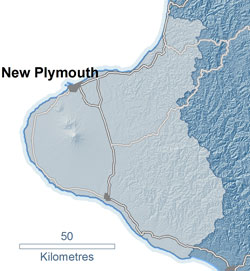Climate change projections for the Taranaki region
This page provides an overview of how the climate in the Taranaki region is likely to change into the future and what implications this has for the region.
This page provides an overview of how the climate in the Taranaki region is likely to change into the future and what implications this has for the region.

Projections of climate change depend on future greenhouse gas emissions, which are uncertain. There are four main global emissions scenarios ranging from low to high greenhouse gas concentrations. This page presents regional projections as a range of values from a low emissions to a high emissions future.
The projected changes are calculated for 2031–2050 (referred to as 2040) and 2081–2100 (2090) compared to the climate of 1986–2005 (1995).
Compared to 1995, temperatures are likely to be 0.7˚C to 1.1˚C warmer by 2040 and 0.7˚C to 3.1˚C warmer by 2090.
By 2090, Taranaki is projected to have from 5 to 41 extra days per year where maximum temperatures exceed 25˚C. Frosts are likely to become increasingly rare in Taranaki by 2090.
Rainfall will vary locally within the region. The largest changes will be for particular seasons rather than annually.
Winter rainfall in New Plymouth is projected to increase by 5 to 9 per cent by 2090.
According to the most recent projections, Taranaki is not expected to experience a significant change in the frequency of extreme rainy days as a result of climate change.
The frequency of extremely windy days in Taranaki by 2090 is not likely to change significantly. There may be an increase in westerly wind flow during winter, and north-easterly wind flow during summer.
Future changes in the frequency of storms are likely to be small compared to natural inter-annual variability. Some increase in storm intensity, local wind extremes and thunderstorms is likely to occur.
New Zealand tide records show an average rise in relative mean sea level of 1.7 mm per year over the 20th century. Globally, the rate of rise has increased, and further rise is expected in the future.
The Ministry for the Environment provides guidance on coastal hazards and climate change, including recommendations for sea level rise.
See Preparing for coastal change: A summary of coastal hazards and climate change guidance for local government. The guidance was updated in December 2017.
By 2090, the region could expect*:
| Spring |
|
|---|---|
| Summer |
|
| Autumn |
|
| Winter |
|
*Projected changes are relative to 1995 levels. The values provided capture the range across all scenarios. They are based on scenario estimates and should not be taken as definitive. For more information, see the full report on climate projections.
There could be increased risk to coastal roads and infrastructure from coastal erosion and inundation, increased storminess and sea-level rise, threatening vulnerable beaches and low-lying areas .
More frequent and intense heavy rainfall events are likely to increase the risk of erosion and landslides. Flooding is likely to become more frequent and severe.
By 2090, the time spent in drought ranges from minimal change through to more than double, depending on the climate model and emissions scenario considered. More frequent droughts are likely to lead to water shortages, increased demand for irrigation and increased risk of wild fires.
Warmer winters may alleviate cold-related illnesses and reduce cold-related deaths, while hotter summers will likely cause heat stress and promote the spread of sub-tropical diseases and their vectors .
Warmer, wetter conditions could increase the risk of invasive pests and weeds over time. Climate change can adversely affect important ecosystems.
Warmer temperatures, a longer growing season and fewer frosts could provide opportunities to grow new crops. Farmers might benefit from faster growth of pasture and better crop growing conditions. However, these benefits may be limited by negative effects of climate change such as prolonged drought or greater frequency and intensity of storms. Competition for water resources may increase, and greater stock losses may be experienced as a result of more extreme events.
The Ministry for Primary Industries website and associated Climate Cloud website have more information on the regional impacts of climate change on agriculture.
Taranaki Regional Council’s climate change information [Taranaki Regional Council website]